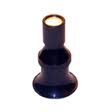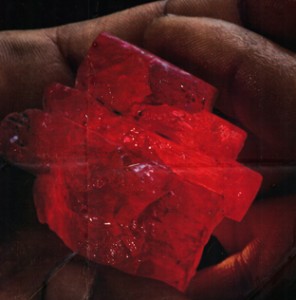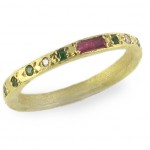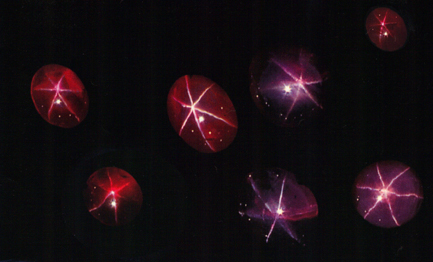Rouge comme l’amour, la passion, le pouvoir et le feu, le rubis irradie de chaleur et de vie. Dans le monde fascinant des gemmes, le rubis est roi et impose sa loi !
Depuis l’antiquité, le rubis fait partie des pierres les plus précieuses. C’est aussi l’une des plus rares, surtout quand il combine couleur, éclat et limpidité…
Caractéristiques
Le rubis appartient à la famille des corindons, (oxyde d’aluminium, AL2O3), la plus abondante famille de gemmes, à laquelle appartient aussi le saphir. Un corindon pur est incolore. Ce sont les traces de fer, de titane, de chrome, cobalt ou vanadium qui colorent la pierre, en bleu, rose, violet ou rouge…
Les corindons, saphirs et rubis, ont une dureté de 9 sur l’échelle de Mohs, ce sont les gemmes le plus dures après le diamant. Le corindon ne peut être rayé que par des diamants ou d’autres corindons.
Son indice de réfraction, qui mesure l’éclat des gemmes est élevé, 1,74 à 1,76. C’est un cristal biréfringent, c’est-à-dire qu’il dédouble les rayons de lumière qui le traversent.
Pour avoir droit à l’appellation de rubis, le corindon doit contenir suffisamment de chrome. Les corindons roses, rouges ou orangés ne contenant pas de chrome sont appelées saphirs roses, rouges, oranges….
Jusque aux 19ème siècle, toutes les pierres rouges, rubis, grenats ou spinelles étaient appelées rubis, c’est à dire « pierres rouges » ou escarboucles « petites braises ».
Ainsi le fameux « rubis du Prince noir » qui orne depuis quelques siècles la couronne britannique est en fait un magnifique spinelle. Et de nombreuses « rubis » présents dans les trésors des musées ou des églises s’avèrent souvent des spinelles ou des grenats quand ils sont analysés.
Trouvez-moi du chrome…
Le chrome est un élément très rare sur notre planète, et alors même que le chrome est nécessaire au corindon pour lui apporter sa couleur rouge, sa présence provoque des fissures et des fractures dans le cristal… Cela explique que très peu de pierres ont pu cristalliser de façon uniforme et atteindre des tailles considérables. Les rubis de plus de 3 carats sont très rares (30 à 50 fois plus rares que les diamants selon le spécialiste Jack Abraham) et les prix au carat des pierres lumineuses et riches en couleur, dépassent largement le prix du diamant.
Le rubis symbole de sentiments passionnés
Rouge rubis… L’élément le plus important pour une pierre précieuse est sa couleur. Le rouge des beaux rubis est incomparable. Chaud et flamboyant.
On lui associe symboliquement le sang et le feu, la chaleur et la vie. Le rubis est donc plus qu’une couleur, il a toujours accompagné l’expression d’un amour passionné.
Origine des rubis dans le monde
Les gisements les plus connus sont situés en Birmanie (Myanmar).
Ces gisements sont connus depuis l’antiquité. Les mines de la région de Mogok produisent des rubis qui ont souvent une teinte un peu rosée. La mine de Mong Hsu, au nord-est, est aujourd’hui la plus importante. Cette mine produit des pierres bicolores, avec un cœur noir violacé et une périphérie d’un beau rouge vif. Par chance, un simple chauffage transforme la teinte sombre en un rouge profond, ouvrant à ces belles pierres, d’un poids pouvant atteindre 3 carats, le marché de la joaillerie.
La Thaïlande a produit de beaux rubis, souvent d’une teinte assez foncée. Mais la production y est devenue très faible. Bangkok reste néanmoins la plaque tournante du commerce des rubis, les négociants Thaïs étant passés maîtres sur ce marché et acquérant une grande partie de la production brute du monde entier qui est taillée en Thaïlande.
Le Viet Nam produit des rubis d’une qualité proche de ceux de Birmanie ; ce qui s’explique par leur même formation géologique. Les premiers rubis furent découverts à Luc Yen, au nord-est d’Hanoï, en 1986. Les rubis vietnamiens vont du rose clair au rouge le plus intense.
On trouve des rubis dans le nord du Pakistan, au Cachemire, au Tadjikistan, au Laos, Népal, et en Afghanistan. En Inde également, d’assez gros spécimens mais très inclus, et donc taillés en boule ou en cabochon.
Madagascar fournit aussi des rubis. Les principales mines sont situées à Andilamena et dans les régions de Tuléar et de Fionarangsoa.
Grâce au géologue John Saul qui a découvert la première mine de rubis d’Afrique de l’Est, le Kenya et la Tanzanie comptent désormais parmi les pays producteurs de rubis et de très belle couleur.
Quel est le rouge le plus beau pour un rubis ? Voilà la question !
Les nuances dépendent beaucoup de l’origine. Quand on parle de rouge birman, on se réfère généralement au rouge le plus intense avec une légère nuance bleutée, mais cela ne signifie nullement que la pierre ait une origine birmane. Cette couleur est parfois appelée sang-de-pigeon, mais rouge birman serait plus exact. Les connaisseurs l’associeront immédiatement aux rubis de Mogok, ou en tous cas aux pierres de grande qualité qui y ont été trouvées. Mais chacun aura son rouge préféré, qu’il soit carmin ou plus bleuté.
La couleur par-dessus tout
La couleur est, pour le rubis, la caractéristique la plus importante et la transparence secondaire, donc des inclusions n’altèrent pas la valeur d’un rubis tant qu’elles ne suppriment pas sa transparence ou si elles ne sont pas situées en plein cœur de la table. (Un rubis rouge brun et sans transparence aura une très faible valeur financière).
Certains rubis présentent un éclat soyeux. Ce phénomène provient de la présence d’aiguilles de rutile. Quand les aiguilles s’alignent sur la structure hexagonale du cristal, elles forment une étoile à six branches. On taille la pierre en cabochon pour faire apparaître et celle-ci semble alors glisser sur la surface du « rubis étoilé ». C’est un des cas où les inclusions, loin de faire perdre de la valeur à une pierre la rendent encore plus précieuse.
De façon générale, quelques inclusions sont comme une empreinte digitale, preuve de l’origine naturelle de la pierre. C’est la taille qui est essentielle, car seule une taille parfaite mettra la couleur en valeur et rendra hommage à sa beauté.
Un rubis parfait est aussi rare que l’amour parfait… Quand on le trouve, il ne faut pas le laisser passer !
Une anecdote
 En 1992, visitant la Namibie, j’achetais des pierres chez un marchand de Windhoek, assez âgé. Alors que j’examinais des tourmalines au dichroscope, il me demanda à quoi servait mon appareil. Je lui répondis qu’il me permettait de distinguer très rapidement les pierres biréfringentes (qui dédoublent le rayon lumineux) de celles qui ne le sont pas et en particulier le verre.
En 1992, visitant la Namibie, j’achetais des pierres chez un marchand de Windhoek, assez âgé. Alors que j’examinais des tourmalines au dichroscope, il me demanda à quoi servait mon appareil. Je lui répondis qu’il me permettait de distinguer très rapidement les pierres biréfringentes (qui dédoublent le rayon lumineux) de celles qui ne le sont pas et en particulier le verre.
« Pourrait-on l’utiliser pour reconnaître des rubis »? poursuivit-il, « car j’exploite une mine ». Je répondis que mon dichroscope permettrait de distinguer les rubis des autres pierres rouges telles que le grenat ou le spinelle, ou même le verre, car ces derniers ne dédoublent pas le rayon lumineux. Mais il ne servirait pas à distinguer des rubis naturels des rubis de synthèse. » Au bout de notre conversation, je lui laissais mon appareil et reçus une petite tourmaline en cadeau.
Un mois plus tard, de retour à Paris, je recevais un paquet, petit mais dense, entièrement recouvert de timbres. Je le déballais et trouvais, enveloppé dans du papier journal, un quartz fumée en forme de sceptre avec inclusions de tourmalines noires. Un bon kilo ! Mon appareil avait dû porter ses fruits !
Dossier réalisé à partir du site www.incolor.org de l’International Coloured Gemstone Association et de l’article de Fred Ward dans le National Geographic.



